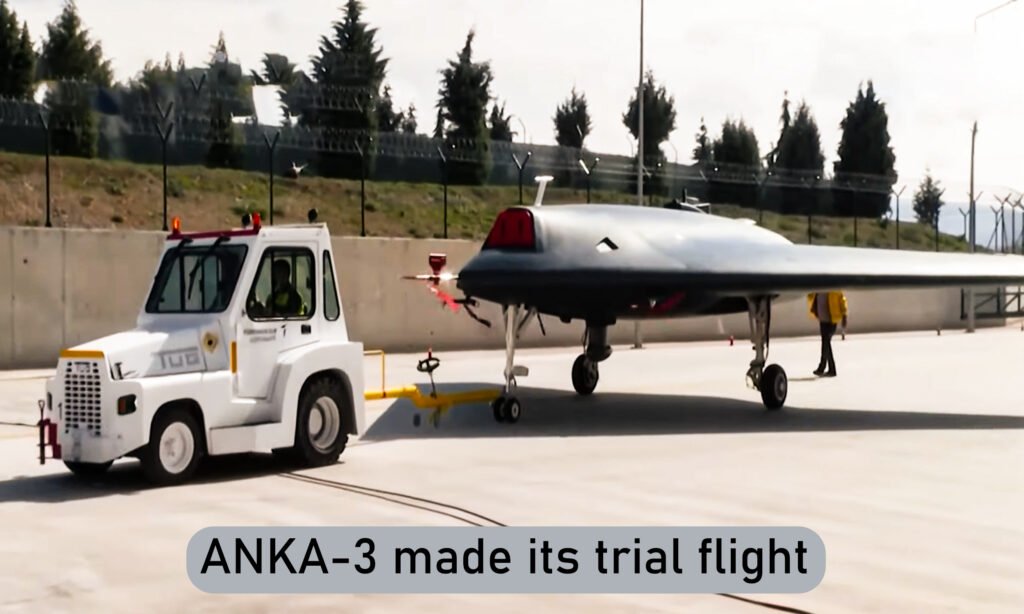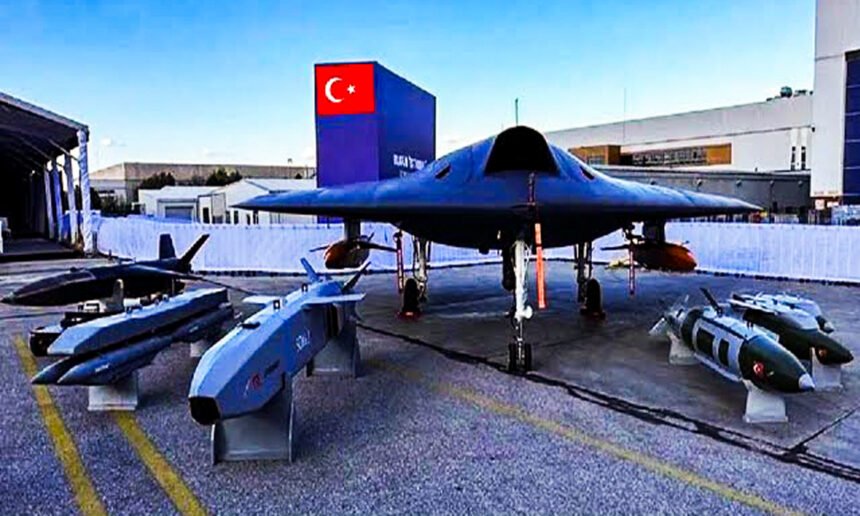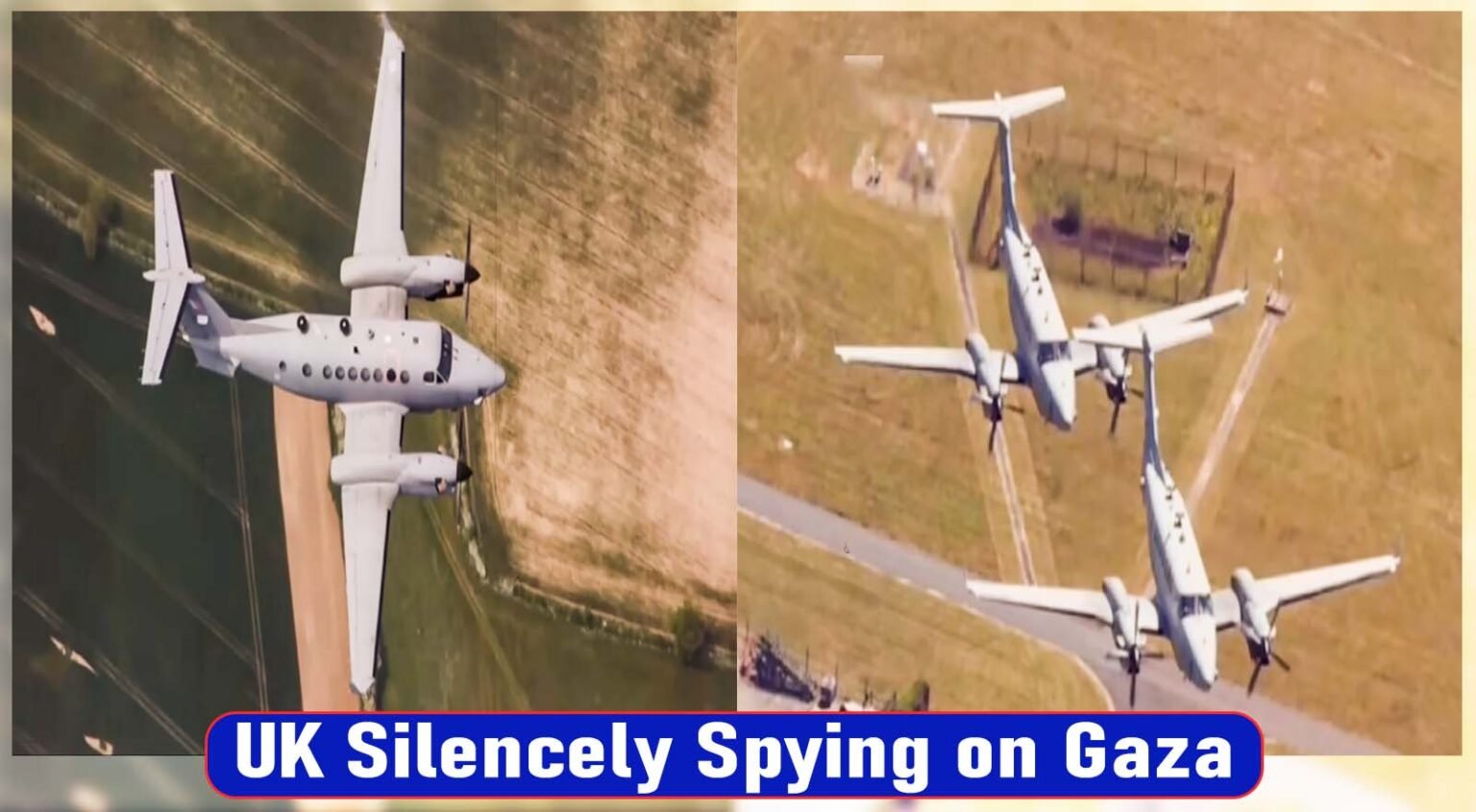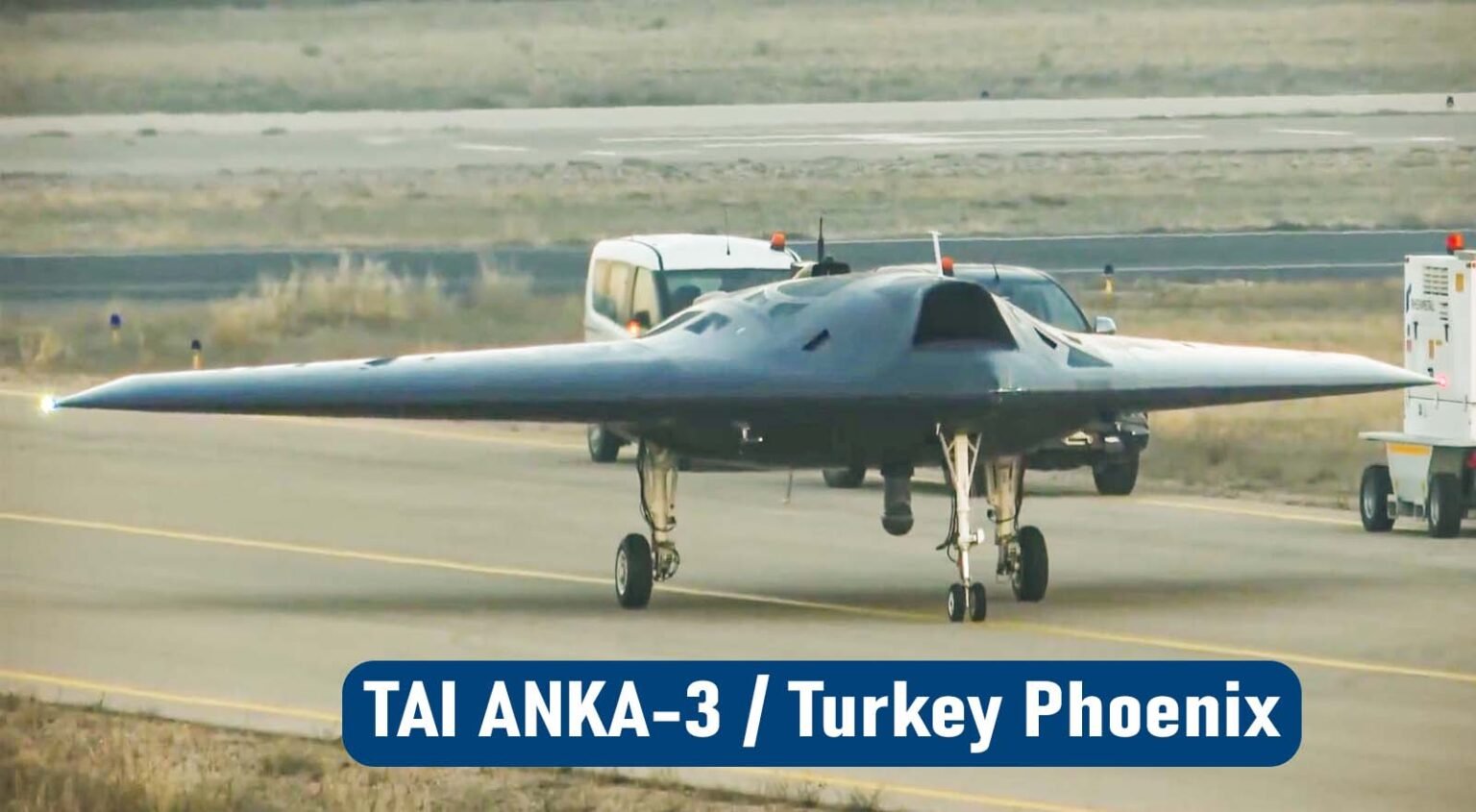TAI ANKA UCAV and Its History
Turkey is set to take the world by storm with its fifth-generation unmanned aerial vehicle. The unmanned aerial vehicle, named Anka 3, flew for the first time. This information was confirmed by Turkish President Recep Tayyip Erdogan. According to the Turkish Aeropress Industry or TAI, the Anka 3 is a system that is very fast due to its jet engine, has a high payload capacity, and its engine is less visible due to its tailless structure. The unmanned fighter jet can carry air-to-air and air-to-surface missiles along with surveillance, intelligence gathering and live video footage. -TAI ANKA UCAV
It can fly at a speed of 0.7 Mach and reach a maximum altitude of 40,000 feet. Earlier, the Turkish fighter jet manufacturer had built the fifth generation fighter TFX-KAAN fighter jet and put the whole special on it. TF-X KAAN was compared with American F-22 Raptor. This time Phoenix has made the whole special again with Anka-3
***** We have compared Turkish drones to. Some of these are HESA Shahed 136, Baykar Bayraktar Kızılelma and ANKA-3
TAI ANKA UCAV Development
In 2004, an agreement was made to create an indigenous Medium Altitude Long Endurance (MALE) Unmanned Aerial Vehicle (UAV) system meet the Turkish Armed Forces’ reorganization requirements. By the middle of 2011, three ground systems and prototypes had been created, produced, tested, and approved. The Anka-A entered serial production in 2012, and the Turkish Air Force received 10 more systems (a total of 30 aircraft) at this time.
The first TAI Anka unmanned aerial vehicle successfully completed its first flight on December 30, 2010, at 15:45 local time, after cruising for 14 minutes. The test flight video of Ankara, which demonstrated the aircraft’s successful completion of the ensuing flight and landing tests, was made public by TAI on May 5, 2011. Anka tested its automated takeoff and landing technology for the first time on November 22, 2011, spending six hours in the air at 20,000 feet. -TAI ANKA UCAV
TAI ANKA UCAV in the image

TAI ANKA UCAV- The Undersecretariat for the Defense Industry was given permission by the Defense Industry Executive Committee on January 5, 2012, to start talks with Turkish Aerospace Industries for the serial manufacturing of ten Anka vehicles. A technical issue caused the Anka prototype to crash on September 27, 2012, during a flying test. The Turkish Air Force accepted the Anka on January 20, 2013, after it had flown for more than 140 hours and to a height of 26,000 feet.
Operation Kiran, Operation Euphrates Shield (2019–2020), Operation Peace Spring, Operation Spring Shield, and Operation Claw-Eagle and Tiger all make extensive use of the Anka, which provides valuable expertise in aircraft development. Beginning in early 2017, TAI’s \imşek, an unmanned target drone coupled with a catapult on the ANKA UAV, marked the beginning of ANKA-S version deliveries.
TAI ANKA UCAV Design choice
TAI ANKA UCAV- The Transportable Image Exploitation System (TIES), Remote Video Terminal (RVT), Automatic Take-off and Landing System (ATOLS), Ground Control Station (GCS), Ground Data Terminal (GDT), three Air Vehicles (A/V), and other Ground Support Equipment (GSE) make up the TUAV system. It can conduct real-time image intelligence, surveillance, reconnaissance, moving/stationary target detection, recognition, identification, and tracking operations.

TAI ANKA UCAV- It is built for both day and night missions, including those in inclement weather. Electro-Optic Color Day Camera (EO Day TV), Electro-Optic/Forward-Looking Infrared/Laser Rangefinder/ Laser Designator and Spotter Camera (EO/FLIR/LRF/LDS), Synthetic-Aperture Radar/Ground Moving Target Indicator (SAR/GMTI), and Inverse Synthetic-Aperture Radar (ISAR) are among the payloads that the aircraft is normally configured to carry. The platform has sensor systems for flight control, electro-mechanical actuators, and a computerized flight control system.
Every piece of flight-critical equipment has dual or triple redundancy, and in operating scenarios, emergency modes are taken into account for fail-safe design. The local defense company Savronik develops ground control systems with full redundancy.
TAI ANKA UCAV General Layouts
Advanced Anka versions with higher payload capacities have been highlighted by Turkey’s Directorate for Defence Industries, expanding Block-A capabilities to include features like SATCOM, SIGINT, and air-to-ground missiles.
The authorities stated that TUSAŞ Engine Industries (TEI) will ultimately create an indigenous 155 horsepower turbo-prop engine for Anka with the assistance of local businesses.
TAI ANKA UCAV Version Details
The ANKA-3, a high-altitude, long-endurance Unmanned Combat Aerial Vehicle (UCAV) developed by Turkish Aerospace Industries, has recently made its maiden flight. Its stealth capabilities, high payload capacity, and multi-mission capabilities make it a significant milestone in Turkey’s defense industry.
TAI ANKA UCAV- ANKA +A,B and S
TAI ANKA UCAV- In 2012, the Turkish Defense Industry Executive Committee announced the development of the Anka +A, a “hunter-killer” High-Altitude Long-Endurance version of the Anka UAV. The Anka +A was planned to carry Cirit missiles from Turkey’s ROKETSAN and would weigh over 4 tons. The UCAV was expected to be presented at IDEF’13 in May 2013.
In January 2015, the Anka-B successfully completed its maiden flight, an improved version of the Anka Block A. It carries an Aselsan synthetic aperture radar/ground moving-target indicator payload and an electro-optical/infrared sensor. The Anka Block B has a greater payload capacity than the Anka-A, including SAR/ISAR/GMTI radar and cameras for high-resolution intelligence data. The Anka Block B paved the way for weaponization in the future.
The Anka-S is a serial production configuration of Anka, equipped with a SATCOM antenna and national flight control computer. It is powered by Thielert Centurion 2.0S and has a payload capacity of SAR/ISAR/GMTI radar. In 2013, the Turkish Undersecretariat for Defence Industry ordered 10 Anka-S UAVs and 12 ground control stations for $290 million. In 2016, the media reported that the TAI was manufacturing 4 Anka-S UAVs for the armed forces, with the first two equipped with StarFIRE 380-HDL FLIR payload.

TAI ANKA UCAV- ANKA-1
Anka-I is a UAV designed by the National Intelligence Organization that is used for electronic warfare and intelligence gathering. Electronic warfare and intelligence systems (ELINT and COMINT) are installed on the aircraft.
TAI ANKA UCAV- ANKA-2
The twin-engined UAV TAI Aksungur (code name: Anka-2) was mostly developed from Anka-S.
TAI ANKA UCAV- ANKA-3
TAI ANKA UCAV- A modified Anka with a stealthy jet engine and flying wing configuration, the Anka-3 is a UCAV. Beginning in April 2023, the Anka-3’s runway testing was conducted. The 28th of December, 2023, marked its first flight. For a duration of an hour and ten minutes, the UCAV was in flight. Its maximum takeoff weight is 6.5 tonnes, and it can carry 1,200 kg of cargo. Its cruising speed is 250 kn (460 km/h; 290 mph), and its maximum airspeed is Mach 0.7 (860 km/h; 530 mph). Its service ceiling is 12,000 m (39,000 ft), and its maximum ceiling is 40,000 ft.
It can hold 100 kilograms (220 lb) of ammunition at each of the outside stations, 650 kg (1,430 lb) at each of the wing inner stations, and 650 kg (1,430 lb) at each of the two stations inside the fuselage. This allows for the integration of a wide range of alternatives, including huge ammunition like Roketsan SOM-J, Mk82, and bunker busters, as well as the ammunition that is now most frequently employed in UAVs.
TAI ANKA UCAV History of operations
The ANKA family of unmanned aerial vehicles (UAVs) developed by Turkish Aerospace Industries (TAI) has a significant operational history, primarily within the Turkish Armed Forces. The three main versions currently in service are Anka-B, Anka-S, and Anka-I. Key operations include Operation Euphrates Shield, Operation Olive Branch, Operation Claw, Operation Peace Spring, Operation Spring Shield, Operation Kiran, and Operations Claw-Eagle and Tiger.
The ANKA series has accumulated over 90,000 flight hours as of March 2021, leading to significant export interest and solidifying its position in the global UAV market. Additionally, ANKA drones have been used for civilian purposes, such as forest fire detection and border control. The development of the ANKA-3 represents the next generation of Turkish UAV technology, potentially entering service in the future and building upon the operational history of its predecessors.
TAI ANKA UCAV Export Records
Ten Anka UAVs were to be purchased by Egypt from Turkish Aerospace Industries in 2012, however the arrangement was subsequently terminated because of differences between the Egyptian military authorities and the AK Party government. Saudi Arabia indicated interest in the Anka UAV in 2013, and Turkish officials stated that negotiations had been ongoing to acquire six systems since 2013.
But no formal agreement has been inked as of yet. The Pakistan Navy started talks with Turkish Aerospace Industries in 2018 after expressing interest in the Anka-S UAV. Turkish Aerospace Industries (TAI) inked a deal with Pakistan’s National Engineering and Science Commission in August 2021 to co-produce Anka military drones. TAI launched its first office in Pakistan in December 2019. Tunisia officially acquired its first Anka-S UAV on November 13, 2021, after signing a contract for $USD 80 million in March 2020 for three Anka-S and three command centers.
Final Conclusion about TAI ANKA UCAV
A series of medium-altitude, long-endurance unmanned aerial vehicles (MALE UAVs) called the TAI Anka is intended for use in intelligence, surveillance, and reconnaissance (ISR) tasks. Designed by Turkish Aerospace Industries (TAI), the Anka series includes versions for electronic warfare and intelligence (ELINT/COMINT) and is largely focused on ISR. The Anka series has high endurance (up to 24 hours), synthetic-aperture radar (SAR) for all-weather imaging, a modular payload system for a variety of sensors and equipment, and satellite connection for real-time data transfer.
The Turkish Armed Forces are the main users of the Anka family, and they sell to Kazakhstan, Azerbaijan, Tunisia, and Qatar. In contrast to unmanned combatants (UCAVs), the Anka family of vehicles is intended primarily for information collection related to battlefield awareness, target acquisition, and intelligence gathering. Because it can carry offensive weapons, the largest and most powerful form, the Aksungur, may resemble a UCAV more. In contrast to the Anka family, the TAI TF-X KAAN is a distinct fighter aircraft program that is still in development, with distinct roles and capabilities.
***** We have compared Turkish drones to. Some of these are HESA Shahed 136, Baykar Bayraktar Kızılelma and ANKA-3
***** You can check out the fighters F-16 Fighting Falcon, F-22 Raptor, Sukhoi Su-57, F-35 Lightning II, TF-X KAAN, KAI KF-21 Boramae and Chengdu J-20.
***** We have compared this Sukhoi Su-57 vs F-35 Fighter jet, f-22 vs su-57, f-22 vs j-20, kf-21 Boramae vs tf-x KAAN, f-22 Raptor VS kf-21 Boramae, F-22 Raptor VS TAI TF-X KAAN, f-16 vs tf-x, f-35 vs f-16 and America vs Russia military power comparison 2024. If you are interested in the military, you can check it out by clicking here
***** You can go to the Turkish Air Force and learn about their drone. To visit the website click here.
Take a look at TAI ANKA UCAV in the video
FAQ
What is the Power of TAI ANKA-3?
The TAI ANKA-3 drone, powered by a Ukrainian AI-450S engine, has advanced capabilities like Mach 0.7 speed, cargo carrying, and stealth. Its strategic implications could strengthen Turkey’s defense, draw international attention, and potentially alter geopolitical balance.
How many versions have TAI ANKA?
The TAI Anka family comprises three models: Anka-B, Anka-S, and Anka-I. The Anka-B is lighter, has shorter range, and is primarily used by the Turkish Air Force and the National Intelligence Organization.
How effective is TAI Anka-3?
The TAI Anka-3, a sophisticated UCAV with advanced features like stealth technology and large cargo capacity, holds potential for Turkey’s export and defense, but its effectiveness depends on testing, operational deployment, and other factors.
What is the history of ANKA?
Turkish Aerospace Industries (TAI) developed the TAI Anka series of Turkish Unmanned Combat Aerial Vehicles (UCAVs) in the early 2000s. The first prototype was launched in 2013, followed by the Anka-S in 2017, Anka-I in 2022, and Anka-3 in 2023.
IS ANKA-3 the best stealth UAV in the world?
The ANKA-3’s stealth performance is complex due to early development, subjective nature, and factors like radar signature, noise, and heat. Assessing its suitability depends on mission objectives.







